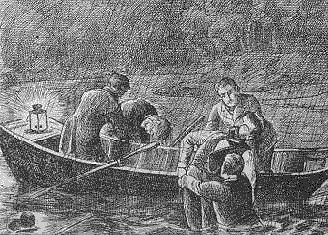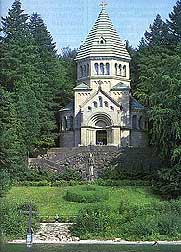June 13th, 1886
Ludwig woke in the early hours of the morning as he was used to, and got up to get dressed. But his clothes had been removed. He was told by a warder to go back to sleep after he was discovered pacing the room in his night-shirt. When the sun rose through grey, rainy clouds, he was not permitted to speak to anyone, and the Royal hair and beard was dressed by a different barber, something which must have unnerved him. Ludwig ate a large breakfast, and even though it was Whitsunday, he was not permitted to attend Mass. (As a devout Catholic, this again must have unnerved him.)
Around 11:00 am, Ludwig asked Dr Gudden if he would accompany him on a walk through the grounds of the castle, as the rain had stopped. They set out for their walk with two warders following at a distance behind, and when they returned, Dr Gudden commented over lunch how well Ludwig was. The treatment is working very well, he commented - the patient seemed quite 'normal' already. Naturally, the fact that Ludwig was 'normal' to begin with never occurred to him. Was Gudden so arrogant as to think that 24 hours in his presence would turn someone suffering a mental problem 'normal'?
Gudden returned from their walk exhausted from all the questions Ludwig had asked. Several wardens were also plagued by the King for answers, and among these questions, Ludwig had very cunningly asked how many guards surrounded the castle grounds and where they were positioned. None of the wardens noticed the significance of these questions, and answered them dutifully.
Ludwig had a large lunch that day, and at about 4:30 pm had requested another huge meal. Gudden tried to dissuade Ludwig from this, but finally agreed to it. During this meal he drank a considerable amount, even though Gudden had set a strict quota on how much alcohol the King was permitted to have.
Just after 6:00 pm, Ludwig sent for Gudden to accompany him on another walk, as had been arranged during their last walk, and the rain had stopped once more. Gudden grudgingly agreed, and he thought Ludwig was behaving so well that the order was given to leave the two men alone, and not to follow them. The King might be even more co-operative if he saw the doctor had such trust.
The two men set out at around 6:10 pm, and both were wearing overcoats and carrying umbrellas, as another storm was threatening. It is recorded that they passed from the castle's view at exactly 6:25 pm. Before departing, Dr Gudden had given orders for dinner to be ready at 8:00 pm.
When 8:00 pm came, and Ludwig and the 62 year old doctor had not returned, Müller thought they must be sheltering from the rain, which was now falling heavily, and didn't think too much about it. A policeman was sent out to look for them, and soon after two more. At 9:00 pm, when there was still no news of them, Müller began to panic at last. It was very unlike Gudden to be out on such a night. It was now dark, and the rain was torrential. Every available man in the Starnberg area was summoned to search for the missing pair with lamps and torches, as it was a very black night. The park was scoured, every inch of ground covered, until, around 10:00 pm, someone noticed a dark object floating in the water at a point where the path was close to the shore. It was the King's jacket and overcoat, and half an hour later, at 10:30 pm, June 13, 1886, the body of King Ludwig II was found floating face down in shallow water, about 20 metres from the lake's bank. Dr Gudden's body was found a few minutes later, floating near the King. Ludwig's watch had stopped at 6:54 pm, Gudden's at 8:00. However, Dr Gudden frequently forgot to wind his watch, so it may have actually stopped at 8:00 am., and the doctor had not noticed it.
 |
An illustration from a newspaper the day after the tragedy.
The bodies were dragged from the water and laid out on the shore. Dr Müller tried for over an hour to resuscitate the King, but at midnight he announced that no more could be done. They were laid into a small boat and rowed back to the castle, and a telegram sent to the Prince Regent in Munich, the most important of the many telegrams that were sent to Munich that night.
